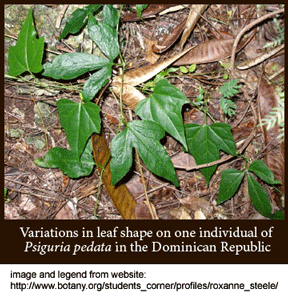Deciphering tropical vines with DNA
 In Dec 2009 Am J Botany researchers from University of Texas apply DNA to sort out species limits of tropical vines in genus Psiguria, part of cucurbit family (Cucurbitaceae) that includes melons, gourds, cucumbers, pumpkins, and squash. Psiguria sp. tax morphological identification due to sometimes drastic changes in leaf and flower structure within and over lifetime of individuals, and frequent absence of male and/or female flowers (approximately 15% of herbarium sheets contain no flowering parts). International Plant Names Index (IPNI) lists 17 species in the genus, although some names are applied to type specimens only. As an aside, IPNI is a model for a dynamic taxonomic names database, containing “names and associated basic bibliographical details of seed plants, ferns and fern allies.” From the website: “[IPNI’s]… goal is to eliminate the need for repeated reference to primary sources for basic bibliographic information about plant names. The data are freely available and are gradually being standardized and checked. IPNI will be a dynamic resource, depending on direct contributions by all members of the botanical community. IPNI is the product of a collaboration between The Royal Botanic Gardens, Kew, The Harvard University Herbaria, and the Australian National Herbarium.”
In Dec 2009 Am J Botany researchers from University of Texas apply DNA to sort out species limits of tropical vines in genus Psiguria, part of cucurbit family (Cucurbitaceae) that includes melons, gourds, cucumbers, pumpkins, and squash. Psiguria sp. tax morphological identification due to sometimes drastic changes in leaf and flower structure within and over lifetime of individuals, and frequent absence of male and/or female flowers (approximately 15% of herbarium sheets contain no flowering parts). International Plant Names Index (IPNI) lists 17 species in the genus, although some names are applied to type specimens only. As an aside, IPNI is a model for a dynamic taxonomic names database, containing “names and associated basic bibliographical details of seed plants, ferns and fern allies.” From the website: “[IPNI’s]… goal is to eliminate the need for repeated reference to primary sources for basic bibliographic information about plant names. The data are freely available and are gradually being standardized and checked. IPNI will be a dynamic resource, depending on direct contributions by all members of the botanical community. IPNI is the product of a collaboration between The Royal Botanic Gardens, Kew, The Harvard University Herbaria, and the Australian National Herbarium.”
Steele and colleagues analyzed 70 Psiguria specimens representing 6 named species, and 14 from closely-related genera, obtained from 9 herbaria in US, Bolivia, and Germany. The target regions were 8 chloroplast intergenic spacers, plus nuclear ITS1, ITS2, and a serine/threonine phophatase intron that prior work suggested might be helpful, for a total length of about 7.7 kb chloroplast and 2 kb nuclear DNA. The authors surmise that the standard barcodes for land plants, namely coding regions of chloroplast genes rbcL and matK, are unlikely to be effective in discriminating Psiguria sp. vines. This may well be true but I hope they will determine rbcL and matK for their well-documented specimens, as this is essential first-pass information for a standardized identification system. Most non-specialists testing an unknown root or leaf will not know if it is a Psiguria sp or even a member of cucurbit family.
On the basis of combined morphologic and molecular data, the researchers conclude the six Psigura species are valid, with caveat that “the molecular results may suggest more than six species” and so “future collections of Psiguria and additional sequencing of molecular markers may contribute to the discovery of additional species.” Finally, Steele and colleagues characterize what they call DNA barcodes, in this case diagnostic nucleotides that uniquely identify the 6 species (1-5 diagnostic nucleotides per species, distributed across 5 chloroplast intergenic spacers). Identification of species-level diagnostic nucleotide characters, together with the relevant primer and amplification protocols, as done here, is a welcome addition to the more usual phylogenetic analysis. However, as mentioned above, for this information to fit into a standardized approach, sequences for the defined markers rbcL and matK are also needed, because that is what will be tested first, except in the minority of situations where the operator already knows the unknown is one of the six Psiguria species.
This entry was posted on Saturday, January 16th, 2010 at 12:02 pm and is filed under General. You can follow any responses to this entry through the RSS 2.0 feed. Both comments and pings are currently closed.